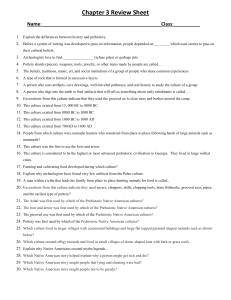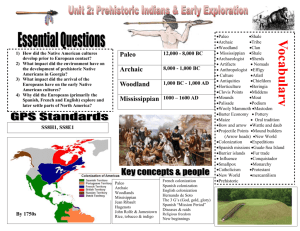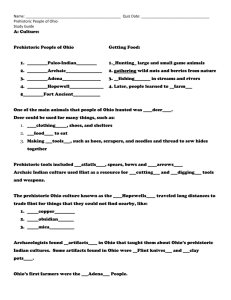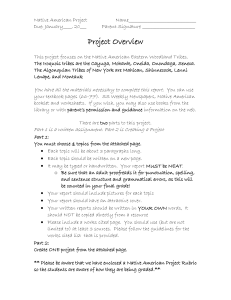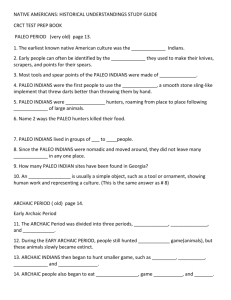Prehistoric Evidence
advertisement
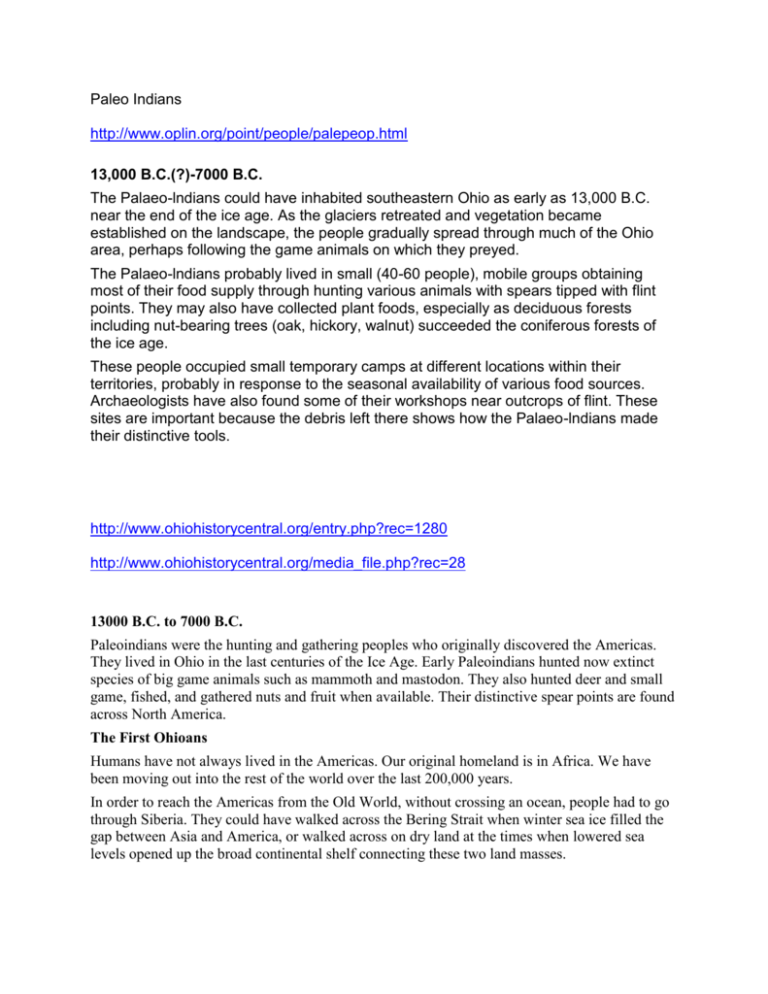
Paleo Indians http://www.oplin.org/point/people/palepeop.html 13,000 B.C.(?)-7000 B.C. The Palaeo-lndians could have inhabited southeastern Ohio as early as 13,000 B.C. near the end of the ice age. As the glaciers retreated and vegetation became established on the landscape, the people gradually spread through much of the Ohio area, perhaps following the game animals on which they preyed. The Palaeo-lndians probably lived in small (40-60 people), mobile groups obtaining most of their food supply through hunting various animals with spears tipped with flint points. They may also have collected plant foods, especially as deciduous forests including nut-bearing trees (oak, hickory, walnut) succeeded the coniferous forests of the ice age. These people occupied small temporary camps at different locations within their territories, probably in response to the seasonal availability of various food sources. Archaeologists have also found some of their workshops near outcrops of flint. These sites are important because the debris left there shows how the Palaeo-lndians made their distinctive tools. http://www.ohiohistorycentral.org/entry.php?rec=1280 http://www.ohiohistorycentral.org/media_file.php?rec=28 13000 B.C. to 7000 B.C. Paleoindians were the hunting and gathering peoples who originally discovered the Americas. They lived in Ohio in the last centuries of the Ice Age. Early Paleoindians hunted now extinct species of big game animals such as mammoth and mastodon. They also hunted deer and small game, fished, and gathered nuts and fruit when available. Their distinctive spear points are found across North America. The First Ohioans Humans have not always lived in the Americas. Our original homeland is in Africa. We have been moving out into the rest of the world over the last 200,000 years. In order to reach the Americas from the Old World, without crossing an ocean, people had to go through Siberia. They could have walked across the Bering Strait when winter sea ice filled the gap between Asia and America, or walked across on dry land at the times when lowered sea levels opened up the broad continental shelf connecting these two land masses. The earliest Paleoindian culture discovered in Ohio so far is the Clovis culture (9500 to 8000 B.C.). The hallmark of the Clovis culture is a type of spear point called a Clovis point. Clovis points have straight sides with no notches. Instead, they have grooves or "flutes" chipped into their bases. These grooves would have helped attach the points firmly to spear shafts. The point and the culture are named for the Clovis site located near the city of Clovis, New Mexico. Here archaeologists first discovered the great age of such points. Paleoindians hunted large and small game animals, fished in the lakes and streams, and gathered nuts and berries. Since they were always on the move their shelters were tents made of wooden poles covered with bark or hides. One of their most important natural resources was flint. They got flint from several sources. In Ohio, their favorite materials were Upper Mercer flint from Coshocton County and Flint Ridge flint from Licking County. Tools made from flint supplied them with all they needed to live. Hunting and gathering bands usually have no chiefs. Leaders are men and women who have earned the respect of the group because of their abilities at hunting, healing, or providing some other needed goods or services. Men and women were free to leave the band at any time to join another or to fend for themselves. The elders would have been highly valued for their experience and knowledge. http://ohsweb.ohiohistory.org/gallery2/main.php?g2_itemId=40 The first Americans came from Asia. When they came and what routes they followed are still uncertain. Current evidence shows that sea levels dropped during glacial periods on earth. The present-day Bering Strait, separating Asia from North America, was dry land during those periods. Thus people and animals could have moved by land from Asia to North America as early as 20,000 years ago. The newcomers to America followed the animals they hunted and gathered plant foods according to the season. They probably lived in small groups called bands made up of a few families, each band having its own territory. Because they had to travel often, the first Native Americans probably built tent-like structures that were easily moved. One person may have been viewed as the best hunter or provider, but many tasks probably required the cooperation of all; likewise, supplies may have been shared equally, or nearly so, between the ablest and those with lesser skills. Like any human society, the newcomers had a spoken language that included a name for their own group. That name is not known because the language no longer exists. Archaeologists call these first Americans, Paleoindians (pay-lee-oh-indians). Archaic Indians Resources: http://www.oplin.org/point/people/archpeop.html 8,000-500 BC The economy of Archaic cultures depended on hunting, fishing, and collecting a wide variety of plant foods in an essentially modern environment. Recent evidence from Kentucky and Tennessee indicates that Late Archaic people may have domesticated squash around 2300 BC. People became increasingly efficient in their adaptation to various environments throughout the Ohio area. Archaic communities established camps in various parts of their territories during different seasons of the year according to the availability of food resources. Some of those camps remained fairly permanent bases where sizeable groups of people congregated periodically. Others were quite small and temporary, perhaps occupied by a single family for a short period of time. In addition to chipping spear points and knives from flint, the Archaic people learned how to make axes and various types of food processing tools by grinding and polishing hard stone such as granite. A growing emphasis on trade and ceremonialism in Late Archaic times foreshadowed developments among the cultures of the Woodland tradition. http://bama.ua.edu/~alaarch/prehistoricalabama/archaic.htm Archaic: from the Greek, meaning Ancient After the Ice Age ended, the environment changed and many of the larger animals became extinct. The sea levels rose, and river deltas became flooded. The weather was warmer, and vegetation changed. The large animals that the Paleoindians Illustration by C. B. hunted were no longer around. People had Dupree (courtesy of to adapt to this new world around them. the Alabama Museum As they adapted, a different stage of of Natural History) culture developed slowly over time, known as the Archaic stage. It continued much longer than the Paleoindian culture did, lasting from 10,000 to 3,500 years ago. About Archaic Life... Archaic people were not as nomadic as their ancestors. Their changed lifeways relied less on migratory animals species. Instead, their subsistence relied more on smaller game such as deer, turkey, rabbit, and even skunk, fox, and wildcat. Archaic Indians made seasonal moves because different food sources were available at different places and in different times of the year. During the fall and winter, they camped in the forested hills. Here the hunting was better and they could also gather nuts. In the summer and spring, they returned to the lower lying river valleys to take advantage of fishing and collecting shellfish, such as mussels. Illustration by Roy S. Dickens, reproduced from Frontiers in the Soil: the Archaeology of Georgia. Shell Middens Some of the most informative areas of the Archaic period are shell middens. These are garbage piles of mussel shells. As people disposed of the shells year after year as they stayed at the same campsite, these piles grew and preserved well over time. Archaeologists find more than just shells in the middens. Archaeologists also find other artifacts that provide clues to what life was like and what activities were taking place there, including hide preparation, woodworking, tool making, and house building. Sometimes cemeteries are found at the sites, which gives us information about the Indians' religious beliefs. Photograph of a portion of the shell midden found at Site 1Ma10, near Huntsville, Alabama. Courtesy of the Office of Archaeological Research, University of Alabama Museums. About Archaic Artifacts... Illustrations by Roy S. Dickens, reproduced from Frontiers in the Soil: the Archaeology of Georgia. The Atlatl Innovative new tools were also added to the Archaic Indians' possessions. One of these was the atlatl. An atlatl, or spear thrower, is a shaft with a weight (bannerstone) and hook on one end which a spear is then attached to. This device aids the spear thrower to hurl his spear farther and faster. Roll your cursor over the picture to the left to find out how the atlatl was thrown. Nutting Stones Another new tool created by Archaic people was the nutting stone, used to grind up nuts and plants (with the aid of a hammer Illustration by Roy S. Dickens, stone). Since the Archaic reproduced from Frontiers in the Soil: the Archaeology of Georgia. Indians had a more sedentary lifestyle than the Paleoindians, heavier stone tools, like nutting stones could be added to the Archaic tool kit. Steatite, or Soapstone, Bowls The Archaic Indians produced stone bowls in addition to stone tools. These bowls are made of a stone known as steatite, or soapstone, and sandstone. Illustrations by Roy S. Dickens, reproduced from Frontiers in the Soil: the Archaeology of Georgia. Step 1. In order to make a steatite vessel, mushroom-shaped blanks were carved from boulders of steatite. Step 2. These blanks were then carved using a wooden mallet and a chisel made from a deer antler. The finished steatite vessel. When the bowls were completed they could not only be used for storage, but they could also be used in cooking by being placed directly over a fire. The stone bowl on the right was recovered from a site on the Tennessee River in Northern Alabama (Newman 2002). Notice the two holes drilled into the vessel toward the back of the picture. These are most likely repair holes. If a crack appeared in a vessel, holes were drilled on either side of the crack and rope or string was threaded through the holes and tied off. This was done in hopes that the vessel would last a little longer. A steatite vessel recovered from the Flint River Creek Site, 1Ma48. Photograph provided by the Office of Archaeological Research, University of Alabama Museums. The Gradual Shift from Archaic to Woodland Pottery was introduced in the Late Archaic period. With its beginnings in present-day South Carolina, Georgia, and Florida, along the Atlantic coast, the production of ceramics began to spread westward into Alabama. Ceramic pots were used in much the same way as the earlier steatite vessels, for cooking and storage. However, with the advent of ceramic technology, came the ability to easily transport the vessels that were much lighter than their stone counterparts. The inventions continued in the Archaic stage. People began to realize that they could encourage plants to grow better. They were not farming yet, but instead helped thin out weeds and/or sheltered wild plants so they could grow better. The first plants “harvested” were hard-rind squash, and bottle gourds, which were also used as containers. People were also sharing ideas and trading goods with others in the region. For the first time, archaeologists find things that would not normally be found in that environment. For example, rocks from the Appalachian Mountains are found in gravesites in Alabama. They were most likely traded from neighbor to neighbor until reaching their final destination. http://ohsweb.ohiohistory.org/gallery2/main.php?g2_itemId=47 By about 8000 B.C., the Ice Age glaciers had drawn back into Canada. The wild rivers of southern Ohio slowly became more calm. Along their banks vast forests of oak, hickory, beech, and elm flourished in the fertile soils. Pine and spruce forests grew on the uplands. After new soil developed on the ice-scoured plains of western Ohio, oak forests and grasslands appeared. In the southeastern part of the state, where there had been no glaciers, hardwood trees still grew. Elm and ash forests developed in the low, marshy Lake Plains of northwestern Ohio. Slightly higher regions became grasslands. Grasses along with elm and ash forests may have spread into the still-dry western Lake Erie basin. Mixed oak and beech forests grew in northeastern Ohio. Throughout Ohio there was much more food for animals and people than during the Ice Age. Thus, their numbers and ranges no doubt grew. The Archaic (ar-kay-ik) Indians who lived in Ohio between about 8000 and 500 B.C. are set apart from the earlier Paleoindians partly because their spear points were different. However, certain "transitional" types of points suggest a slow shift from one culture to the other. Some types of well-made Archaic points show that the flint-working techniques of the Paleoindians were carried forward. However, later changes by the Archaic Indians marked them as a distinct group. The term "Archaic" describes hunting and gathering societies who did not farm, make ceramics, or live at permanent sites. Still, Archaic groups were not culturally-poor. According to recent research, Archaic people had comfortable lifestyles, especially where there were many resources. Indeed, studies in various parts of the world have shown that some hunting and gathering groups living today spend less time getting food than do farmers. Video: http://www.youtube.com/watch?v=t9NnMVsJkAE&feature=youtube_gdata_player Woodland Indian Resources http://bama.ua.edu/~alaarch/prehistoricalabama/woodland.htm The Woodland Stage is identified throughout the Eastern United States. It is characterized by an increased dependence on cultivation, the concentration of the population into more permanent towns and villages, a widespread emphasis on ceremony, and the introduction of both pottery and the bow and arrow. Artist's reconstruction by Martin Pate, provided courtesy of the Southeastern Archaeological Center, National Park Service. About Woodland Life... Like their Archaic predecessors, Woodland Indians hunted small game and foraged in the forests. However, unlike their Archaic forerunners, Woodland Indians placed greater emphasis on a more sedentary life by tending plants and cultivating maize, sunflower, beans, and squash. With this increased importance placed on cultivation came an increased need to settle in one place for longer periods of time. Thus, towns and villages appear to be occupied year round. In the spring, summer, and fall the Woodland Indians hunted and tended their gardens. By drying the meat and storing their crops and gathering nuts, the Woodland Indians could remain in their villages during the lean winter months. Illustration by Roy S. Dickens, Jr. Reproduced from Frontiers in the Soil: The Archaeology of Georgia. Conical mounds Mound building first appeared during the Archaic Stage. However, conical mounds are most Sauls Mound at Pinson Archaeological Park. Photograph provided courtesy of Chris Wilkins. often associated with the Woodland Stage. The Alabama landscape is dotted with numerous conical mounds, nearly all of which are currently on private land. However, just over the TennesseeAlabama border is Pinson Mounds, a Tennessee state archaeological park. Fifteen mounds and many other earthworks make up the nearly 1,200 acre park. The tallest mound at that park is Sauls Mound with a height of 72 feet. Archaeologists believe this mound and, indeed this site, was used for ceremonial purposes. About Woodland Artifacts... Effigy Pipe. Photograph provided courtesy of the Office of Archaeological Research, University of Alabama Museums. Pipes Pipes first begin to appear in Archaic contexts. Yet, due to the large number that are found in Woodland contexts, they are most often associated with the Woodland Stage. As people began to aggregate into permanent village settings, a more elaborate ceremonial life seems to have evolved. Smoking from elaborate pipes became part of this new ritualism. The effigy pipe pictured above represent a dog and is made of greenstone. This pipe was recovered from Site 1Ms55, in Marshall County near the Tennessee River. Reels Copper reels are gorgets that were worn on the chest of, presumably, someone of importance. Reels first appear in archaeological contexts in the Ohio Valley. Archaeologists believe that through exchange and contact with Ohio Valley Indians, copper reels spread, or diffused, further south into Mississippi, Tennessee, and Alabama. Many were uncovered during the 1930s TVA excavations that took place in Northern Alabama along the Tennessee River. Photograph provided courtesy of the Office of Archaeological Research, University of Alabama Museums. Grinding Stones Equally important during the Archaic Stage, grinding stones, like nutting stones, were used to grind nuts, such as acorns, pecans, and walnuts, which were crushed into flour, or meal, with a pestle (pictured far right). Illustrations by Roy S. Dickens, Jr. Reproduced from Frontiers in the Soil: The Archaeology of Georgia. Bow and Arrow One of the hallmarks of the Woodland Stage is the invention of the bow and arrow. Just as the atlatl increased the power of a spear, the invention of the bow and arrow produced a more powerful weapon than the spear and atlatl. The bow acted as a spring that, when released, was quick and forceful. With the adoption of the bow and arrow, came the need for smaller projectile points. Illustration by Nathan H. Glick. Reproduced from The World of the Southern Indians. Pottery Another defining hallmark of the Woodland Stage is the widespread adoption of pottery. The earliest pottery appears to have been made in the coastal regions of South Carolina and Georgia during the Late Archaic. By the beginning of the Woodland Stage, the knowledge and use of pottery had spread into Alabama and continued to spread further west into the Mississippi River Valley. http://mason.gmu.edu/~jjarski/portfolio/fall07/easternwoodland#east The Eastern Woodland Indian were made up of many tribes. The most known of these tribes were the Powhatan, Mohawks, Iroqoius, and the Susquehanna. Most of these tribes belonged to a group of tribes called the Iroquois Nation. The Iroquois tribes all took animals as there tribal symbol and would mark all of their communications between each other with that symbol. Also when the tribes would meet the chiefs of the different tribes would always wear a animl skin that was designed to look like the tribes sacred animal. The Eastern Woodland Indians inhabited a wide area in the eastern part of the United States that extended eastward from the Mississippi River, through the Great Lakes region, to the Atlantic Ocean. The inhabitants in this region were forest dwellers living in a vastly wooded area that extended, not only from Lake Superior to the Atlantic Ocean, but south from Canada into the southern states of Kentucky and Virginia. All of the Eastern Woodland tribes, which include the Powhatan, were a stationary tribe. This meant that the tribes did not move very much, except when they were in search of food. This meant that they needed to create their own types of shelter. The Eastern Woodland tribes lived in homes called "longhouses", which all varied in size depending on how big of an area they had to use, as well as how many families were going to live in them. It was not uncommon to see 20 different families living in one longhouse. The longhouses were rectangular in shape, used saplings (baby trees), and branches for the frames. The branches were then woven together using the bark from the trees. Most Eastern Woodland tribes would then use animal skins, wood, and hay to construct their homes. Like most longhouses used by the Eastern Woodland Indians, they contained shelves that could be used for storing food, equipment, and tools. While it was common for the Indians to sleep on the floor, some homes had platforms or racks that could be used as beds or chairs. The Indians in these homes slept on platforms lined with deerskin on each wall. In the center of this longhouse was an area to build a fire which was used for keeping warm in the winter or for cooking during rainy weather. Some larger longhouses might contain more than one place to build a fire. A hole built into the top of the longhouse served as a chimney to allow smoke to rise from the fire and ventilate to the outside. Most of the longhomes also would include shelves and drying racks where they would put the skins of the animals they killed to dry to use in their clothing, as food, and as part of new homes. Food The Northeastern Woodland Indians were expert farmers and farming was the main focus of their lives. Though primarily farmers, they were also skilled hunters and animals were a staple in their diets. The Indians also fished the fresh waters of the many rivers and streams throughout the region using hooks, spears, and nets. Tribes along the coastal Atlantic waters also dug for shellfish such as oysters and clams.Many tribes planted corn, beans, and squash which they called the "Three Sisters". In addition to the three principal crops, gourds, Jerusalem artichokes, melons, pumpkins, sunflowers and tobacco were also grown. They also gathered seeds, berries, and nuts. They dried berries, corn, fish, meat and squash for the winter. Jobs The Northeastern Woodland Indians had their own farm plot and each member of the family had an important responsibility. The women of the family were responsible for gathering wild plants, such as berries, nuts, and edible plants and flowers. The men's responsibility was to hunt, fish, and fell trees to make canoes. Many of the Eastern Woodland tribes were not nomadic and relied on agriculture to provide food for the tribe. Being expert farmers, farming was the main focus of their lives. The Iroquois lived in areas that provided good farm land and the Powhatan also cultivated the land for food. Women usually did the cultivating after the men had cleared the land and, along with their children, spent a lot of time in the fields during the spring and summer seasons. It was probably the women who experimented with agricultural techniques that resulted in the successful cultivation of domestic crops. The women in a Powhatan, or Eastern Woodland tribe held a very high role. They lived in what is called a matriarchal society, which just means women were the most important. This was due to the fact that the Eastern Woodland tribes believed that eaverything had a spirit and that the most important spirit was called "Mother Nature". Since women were the ones who cared for the children they were "kindred spirits" to mother nature. The children mostly got to play during the day when they were young. Children were expected to go into the gardens to help their parents work everyday. Boys would go out with the men of the tribe and learn how to hunt, track, and gather food for the tribe. Their main job was to learn how to be a Powhatan Indian. At the age of ten, boys would be blindfolded and taken out to somewhere in the woods. If they were able to make it back to the village, and many did not, then the tribe had a huge celebration to celebrate them entering manhood. They were then expected to go on hunts, protect the village and the tribe, as well as find a wife. The girls were taught by their mothers how to be a good wife. They were taught how to farm, how to take care of the children, how to make clothing, and were expected to marry by their eleventh birthday. Transportation The Eastern Woodland tribes were not nomadic tribes, which means they did not movearound. Their homes were built on the ground and were not easily moved. However, there were times when it was necessary for them to move around. Some of the reasons they may have needed to move around were for hunting, gathering of food, when there was a drought, if an enemy was trying to envade, or food was scarce in the area they were in. When times like these occured they would dug-out canoes to get around which enabled them to travel over water for short distances, follow food that uses water to try and escape, and to fish easier using nets. The Powhatans would also walk every where they went. Since they were not nomadic they did not need to walk far, so it was not a big deal. Though it would not be out of the ordinary if you saw someone walk three days to get where they needed to go, or in search of food. The Eastern Woodland tribes were one of the first to use animals to help them. The Powhatans would use the dogs/wolves to help them hunt by scaring the animals and then shooting them with their bows and arrows. Some of the Powhatans would use the dogs to help them carry their hunting supplies and carry the food back to the village. The thing about these dogs are that they were free, they were not a pet and so were allowed to roam free, but they still hung around the villages. Many of the Eastern Woodland tribes believed that this was because the dogs were the spirits of their ancestors helping them to survive. Art, Clothing, and Tools Powhatan warriors used tomahawks or heavy wooden war clubs. They also carried shields to protect them from animal attacks, as well as attacks from a waring tribe. Powhatan hunters used bows and arrows. Fishermen used nets and pronged spears to catch fish from their canoes. All of these tools were made from animals that they had killed. No part of an animal was wasted because they felt that if they wasted something the spirits would retailate against them and something bad would happen to the tribe or to them individually. Some examples of ways they used the whole animal are they would use the stomachs of animals to hold water, they would use the bones and teeth to make their tools/weapons, and they would even use the bones to create pipes and spoons. Powhatans usually wore a beaded headband with a feather in it. They painted their faces and bodies with different colors and designs for different occasions, and both men and women often wore tattooes. Powhatan women wore knee-length skirts and the men wore breechcloths with leather pant legs tied on if the weather was cool. Traditionally the Powhatans did not wear shirts, although they did wear cloaks made of turkey feathers or furs in the winter. Both genders wore earrings and moccasins on their feet. Today, some Powhatan people still have traditional headbands or moccasins, but they wear clothes from today like jeans instead of breechcloths and they only wear feathers in their hair on special occasions. The Powhatan Indians are known for their beadwork and basketry. The Powhatans crafted wampum out of white and purple seashells or shell beads. Wampum beads were strung together in many different patterns. The designs usually told stories about important events or a family. Wampum was used like money. The Powhatans would trade the white man wampum for goods. Wampum belts would be made into pictures showing the reason it was made. All Indian messengers carried wampum belts when going to other tribes because they were used as a form of communication between Indian tribes. The baskets that the Powhatan Indians would weave, were made from the bark of trees. They coated the baskets with pine pitch to make them waterproof. They were very light in weight. The Powhatans used these baskets for gathering berries, nuts, water, corn, beans, and squash. http://www.fcps.edu/KingsParkES/student%20pages/indians/woodland/woodland.htm Location The Woodland Indians lived in the northeastern part of the United States. Houses The Woodland Indians lived in wigwams and longhouses. Wigwams were made of young sticks bent into a half circle. Birch bark was put over it and a thin layer of grass. Longhouses were rectangular homes. Longhouses were also made out of young sticks. On top of the frame of sticks they would sew together bark. Inside the longhouse there would be sleeping platforms,with deerskin along each wall. There were also shelves to hold baskets,pots, and animal skins. Sometimes as many as 12 families lived in a longhouse. Food They hunted, fished, and got Clothing berries, fruit, and nuts. The men wore shirts, leggings, and Woodland Indians were also moccasins of animal skins, often farmers. They planted corns, deer. The women wore skirts beans, and squash. They used woven from grasses with furs on bows and arrows and traps to top and leggings underneath. In the catch animals. Could you summertime, men changed to ever imagine eating your buckskins and women wore grass shoes? The Iroquois Indians dresses. made soup with their shoes when they couldn't find food to eat. Wampum Wampum was used as money. Wampum was made with purple and white shells. It was also used to show that you were not the enemy when one indian visited another indian tribe. They used wampum to decorate their clothing and jewelry. Here are some of the shells they used to make wampum. Woodland Indians also used porcupine quills and beads to decorate their clothing and make jewelry. LATE PREHISTORIC INDIANS http://www.ohiohistorycentral.org/entry.php?rec=1282 http://www.ohiohistorycentral.org/media_file.php?rec=6 A.D. 900 to 1650 The Late Prehistoric Period refers to the time immediately before the movement of Europeans into the Ohio country. The American Indian cultures occupying Ohio during this period lived in large villages often surrounded by a stockade wall. Sometimes they built their villages on high ground overlooking a river. Leadership may have become centralized in one or two leaders, perhaps including a war chief. Late Prehistoric people grew maize (or corn), beans, and squash in their fields. They continued to hunt, fish, and gather wild plant foods, but maize was, by far, their most important source of food. Their ritual life was centered on the plazas at the center of their villages and often the dead were buried in graves surrounding the plaza. Effigy mounds represent a new development during this period. Serpent Mound and the Alligator Mound appear to have been shrines to important spirits that still were revered by the tribes of the historic period. During the Late Prehistoric Period, several distinctive cultures arose in different parts of Ohio: the Fort Ancient culture in central and southern Ohio, Sandusky culture in northwestern Ohio, Whittlesey culture in northeastern Ohio, and the Monongahela culture in eastern Ohio. The Late Prehistoric Period also is called the Mississippian Period. In the Mississippi Valley and in the Southeastern United States, large cites grew up during this time. The largest was Cahokia in Illinois. Perhaps similar large cities would have become established in Ohio, but the Beaver Wars and then the movement of Europeans into the region forever changed the lives of Ohio's American Indian peoples. http://www.oplin.org/point/people/ftanpeop.html A.D. 1000-1650? Fort Ancient (southern Ohio), Sandusky (northwestern Ohio), Whittlesey (northeastern Ohio), Monongahela (eastern Ohio) Late Prehistoric peoples lived in villages located in areas of fertile soil that could support cultivation of corn, beans, and squash. Although their crops supplied a major portion of their food supply, they also hunted game (with bows and arrows), fished, and collected wild plant foods and nuts. Periodically, perhaps every 10-15 years, declining fertility of the crop land, decreasing supplies of wood and game, and increasing sanitation problems forced the villagers to move their community to a new location. Each groupFort Ancient, Sandusky, Whittlesey, and Monongahela-had its own distinctive ways of making and decorating ceramic jars and bowls. Although the picture is far from clear, by the early 17th century, these Late Prehistoric people were either eradicated by other Indian groups, were decimated by the diseases spreading from the European colonies on the East Coast, or moved out of the Ohio area to avoid these problems. Wyandot, Delaware, Shawnee, and Miami Indians (among others) then moved into the Ohio area shortly before the advent of early European explorers and missionaries. The Fort Ancient people occupied most of the river valleys of southern Ohio, northern Kentucky, and western West Virginia. Their villages consisted of a number of rectangular houses often grouped around an open plaza area. In some instances, they protected their community by erecting a wooden fence or stockade around it. http://www.fortancient.org/index.php?option=com_content&view=article&id=36&Itemid= 43&limitstart=5 Late Prehistoric Period AD 1000 - 1750 The Late Prehistoric Period is the final period of the prehistoric era in Ohio and is perhaps the best known. Although other unrelated groups thrived along Lake Erie to the north, southern Ohio was populated by a culture referred to as Fort Ancient. This culture is related to larger and more complex Mississippian cultures to the west and throughout the southeastern United States. There is clear interaction with Missippian groups in the form of trade goods and shared symbolism. Some archaeologists see the Fort Ancient as an offshoot of the Mississippians, while others regard them as a unique and separate culture. The Fort Ancient culture are generally thought to be descendents of Late Woodland predecessors. The Fort Ancient are notable for their intensive reliance on corn agriculture and their large, densely occupied villages, such as SunWatch Indian Village in Montgomery County. The Fort Ancient people had large villages that generally included about 100-500 residents. This number varied with the season as people would leave the village in the winter to live in hunting camps. The villages were substantially larger and more sedentary than the Late Woodland and were occupied for at least 20-30 years. SunWatch Indian Village is the most thoroughly excavated village attributed to this culture. The village structure was a pattern of concentric circles with a plaza in the heart of the village. Surrounding the plaza was a circular cemetery zone in which deceased villagers were buried. Although some individuals appear to have grave goods and other indications of status, there are also individuals of corresponding lower status and children represented. Around the burial zone, there is a circular zone of storage pits, trash pits, and work/cooking areas. Surrounding the work zone is another circular ring of domestic structures. Houses were rectangular in shape and ranged in size from 16 to 22 ft wide and 19 to 30 ft long. The village was surrounded by a substantial stockade despite a general lack of evidence for warfare. As the population continued to grow, corn (“maize”) became the primary crop, supplemented with beans and squash. These three plants were grown together and were referred to by historic Native Americans as the “three sisters.” Fort Ancient nutrition was poor, lacking diversity and protein. Approximately fifty to seventy-five percent of the diet was composed of corn alone. The Fort Ancient hunted deer extensively, but also relied on elk, turkey, bear, and small game. Nuts, fruits, and berries were also gathered. The Fort Ancient people of Southern Ohio are known for the construction of two animal effigy mounds – Alligator Mound in Granville and Serpent Mound in Peebles. These effigy mounds were not burial sites, but were probably more ritualistic in nature, serving as ceremonial sites. The “Alligator” was originally interpreted as an alligator, it is more likely that the mound represents an opossum or panther and the name was a mistranslation by early settlers. As Europeans began settling North America, they began trading goods with the native peoples. Europeans goods made their way through native hands into Ohio long before Europeans ever crossed the Ohio River. Some later Fort Ancient culture sites include a few European trade goods such as beads, but few if any early European explorers ever saw a Fort Ancient village. Archaeological sites attributed to the Fort Ancient culture disappear fairly abruptly around A.D. 1650. It is unclear what relationship, if any, the Fort Ancient have to the historic tribes encountered by later explorers. Large villages and most of the middle Ohio River Valley may have been largely unpopulated for at least fifty years. The introduction of European diseases may have decimated Fort Ancient people leading to their virtual disappearance, though there is no direct archaeological evidence supporting this popular idea. It has been suggested that the Fort Ancient were driven out by conflict with contemporary groups, also an idea unconfirmed by archaeological evidence. Historic Period AD 1750 - Present Europeans made their way into Ohio fairly late in contrast to other regions. Reliable descriptions of the Ohio River Valley do not appear until around the mid-1700s. The tribes found living in Ohio at that time include the Shawnee, Miami, Delaware, and others, of which none may be directly related to the prehistoric Fort Ancient. The Shawnee tribe is often described as the most likely historic descendent, though it is difficult for historians and archaeologists to find any definitive links. The Shawnee were an exceptionally fragmented group in the sixteenth and seventeenth centuries, with many relocations, fissions, and conflicts with other tribes. Prior to Europeans encountering them in southern Ohio, the Shawnee were encountered in Maryland and Pennsylvania. The Miami, Delaware, and other tribes were likewise observed in other states prior to being encountered in Ohio. Regardless of whether or not the historic tribes were related to the prehistoric cultures described by archaeologists, there is no question that historic period people lived in dynamic and threatening times. The natives faced several hurdles and challenges to their way of life as settlers moved into the region. They were confronted with diseases in which they had no natural immunities, trading posts were built within their territories, missionaries tried to convert them to Christianity, liquor was introduced, and settlers were expanding into Ohio. The European settlers forced their way into the Ohio Valley and fought continuously for the rich and fertile land of Ohio. By the end of the War of 1812, most of the native tribes were defeated, both militarily and in spirit. Many moved westward, but a few remained in defiance. In 1830, the United States Congress enacted the Indian Removal Act which forced all natives living in the Northwest Territory, which included Ohio, to move west of the Mississippi to government-designated lands, or reservations.
